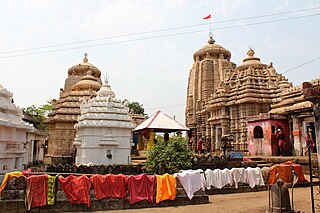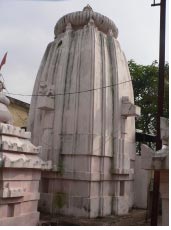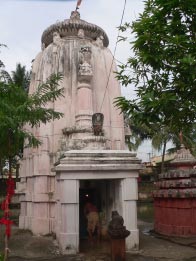Jalesvara Siva Temple Precinct is a Hindu Temple dedicated to Shiva situated on the southern outskirt of the village Kalarahanga at a distance of 2.00 km from Patia and 6.00 km south of Chudangagada in the northern outskirt of Bhubaneswar, Odisha, India. The presiding deity is a Siva-lingam within a circular yonipitha inside the sanctum, which is 1.15 meters below the chandrasila. The sanctum measures 2.00 square meters.

The Kapilesvara temple is a Hindu temple dedicated to Shiva located in the south western outskirt of the village Kapilesvara, Old Town, Bhubaneswar, Odisha, India. It is located at the end of Kapilesvara road leading from Lingaraj temple to Kapilesvara Village. The presiding deity is a Siva-lingam at the center of a circular yonipitha inside the sanctum. It is a living temple, facing towards east and maintained by Kapilesvara Temple Trust Board. The temple is situated within the precinct along with 33 other monuments. The precinct is located on the northern embankment of Manikarnika tank over an area of 44.00 square metres.
Nilakanthesvara Shiva Temple is a temple in Orissa, India, located on the western embankment of the Bindusagar tank. It is situated on the left side of the lane branching from the road leading from Kedar Gouri chowk to the Vaitaḷa deuḷa in Bhubaneswar, the capital state of Orissa. The temple faces east. The temple's enshrining deity is a circular yoni pitha with a chlorite Siva lingam. The temple is made out of sandstone. The present temple is a recent construction over the remains of an earlier one. The building material is old but the entire structure now has cement plaster and an enamel point.

Arjunesvara Siva Temple is a 12th century A.D. temple in Bhubaneswar, in the state of Orissa, India. The temple is situated on the southern embankment of the Bindusagar tank at a distance of 70 metres and situated on the right side of the ratha road branching from the road leading from Lingaraja temple to Ramesvara temple. The temple is facing towards west.
Chandrasekhara Mahadeva Temple is a Hindu temple dedicated to Lord Shiva located in the village Patia, Bhubaneswar, Odisha, India. The enshrined deity is a Shiva lingam within a circular yoni pitha. The temple has a private ownership but is held by many people at the same time.
Bharati Matha Temple is a temple of the Hindu God Siva in Bhubaneswar, Orissa, India, The temple is a Hindu monastery with three stories which was built in the 11th century AD. It is currently used for living Matha purposes and earlier it was used as a Hindu pilgrimage centre.
Markandesvara Siva Temple was constructed by Kesaris to commemorate the visit of sage Markandeya, same as the Samesvara Siva temple. It is an abandoned temple and is facing towards the east. However at the center of the sanctum there is a Siva-lingam with the circular Yoni pitha. The temple is totally covered with wild vegetations.
Nilakantha Siva temple is located in the Kharakhia Baidyanatha temple precinct, Kharakhia Vaidyanath Sahi, Old Town, Bhubaneswar. One can approach to this site on the left side of the Vaidyanath road leading from Lingaraja temple to Kapilesvara. This is a living temple and is facing towards the west. The enshrining deity of this temple is a Siva lingam within a circular yoni pitha at the centre of the sanctum sanatorium. The sanctum is 0.77 metres below the chandrasila.
The Somesvara Siva temple is located in the Kharakhia Baidyanath temple precinct in Kharakhia Vaidyanath Sahi, Old Town, of Bhubaneswar. It is located approximately 300 metres south of Lingaraja temple. Visitors may approach the site on the left side of Baidyanath Road leading from Lingaraja temple to Kapilesvar. It is a living temple and faces towards the west. The enshrined deity of this temple is a Siva lingam within a circular yonipitha at the center of the sanctuary located 0.93 metres below the chandrasila. The temple is under the care and maintenance of Babulal Makaddam Badu Mohapatra, the chief priest of the temple, on whose private land the temple stands.
Patalesvara Siva Temple – III is a Siva temple located on the Mandir Chowk of Old Town, Bhubaneswar, Orissa, India. The temple dates to the 13th century AD.

Isanesvara Siva Temple is a 13th-century ad temple in Bhubaneswar in the state of Orissa, India. The time period of its construction is estimated from its architectural features and it is suggests the temple to ganga period. Isanesvara Siva temple is in the Goasagaresvartemple precinct, on the left side of Ratha road old Town, Bhubaneswar. It is one kilometre (0.62 mi) west of Lingaraja Temple and one km south of Ananta Vasudev, 300 m (980 ft) southwest of Ramesvara temple and 200 m (660 ft) northwest of Baitala Deula. The temple is facing towards east. The presiding deity is only a circular yon pitha. The lingam is missing.

Paradaresvara Siva Temple is a 13th-century AD temple in Bhubaneswar, Odisha. The time period of its construction is estimated from its architectural features and it suggests that the temple must belong to the ganga period. Paradaresvra Siva temple is situated in the Gosagaresvar temple precinct. It is located on the left side of Ratha road old town, Bhubaneswar. It is located at a distance of 1 km west of Lingaraja Temple and 1 km south of Ananta Vasudev, 300 metres southwest of Ramesvara Temple and 200 metres northwest of Vaital Temple. The temple is facing towards east. The presiding deity is only a circular yonipitha in the cella that measures 3 square metres. The lingam is missing.
Lakhesvara Siva temple Location: Lat 20° 14’ 33"N, Long 85° 50’ 17" E, Elev 60 ft. Approach- Lakhesvara Siva temple is located in the right side of the Ganges–Yamuna road, behind the Lingaraja market complex, Old town, Bhubaneswar, Orissa, India. It is situated at a distance of 70 metres north east of Lingaraj temple and at a distance of 10 metres south of Gangesvara and Yamunesvara Siva temple across the road. The temple is facing towards the east. The enshrining deity is a Siva lingam within a circular yoni-pitha, which is 0.77 metres below the chandrasila.
Papanasini Siva Temple is an abandoned Hindu temple located in Bhubaneswar, Orissa, India.
Visvanatha Siva Temple is a Hindu temple dedicated to Visvanatha and is one of the temples of Bhubaneswar, a revered pilgrimage center and the capital of the state of Orissa, India. It is a living temple, facing west, situated on the road from Lingaraja Temple to Mausima Temple. The presiding deity is a Siva lingam with a circular yoni installed inside the sanctum that was brought from Kasi. The temple was built in the 19th century and is of modern construction.
Subarnesvara Siva temple is situated on the left bank of Lingaraja west canal, Bhubaneswar, Orissa, India. The east facing ancient temple enshrines a Siva lingam within a circular yoni pitha in the sanctum measuring 2.35 square meters.
Sukutesvara Temple located in the old town of bhubaneswar, Odisha,India,serves as purpose for community gathering. The preceding deity in this temple is a Siva- lingam situated at the centre. The temple observes various religious sacraments like Mahasivaratri, Chandipatha and Rudrabhisekha.
Sinduresvara Siva temple is located in village Sundarpada, Old Town, Bhubaneswar, Odisha, India. It is on the right side of the road leading from Lingaraj temple to Sundarpada. The enshrined deity is a circular yonipitha facing towards the north. The Siva lingam decayed in course of time. In April 2013 the villagers raised funds and reestablished new Shiv Linga. There are two entrances on the south-west and northwest corners provided with seven flights of steps leading down to the temple.

Bata Mahadeva (Mukteswara Shiva) is a Hindu temple, dedicate to Lord Shiva. This is one of the oldest temple in Bhubaneswar (The Temple city of India), a well known heritage place and capital of Odisha.

Manibhadresvara Siva temple is located in Bhubaneswar, Orissa, India.








